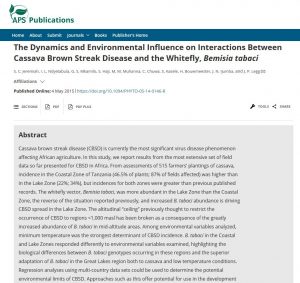Cassava brown streak disease (CBSD) is currently the most significant viral disease phenomenon affecting African agriculture. In this study, we report on results from the most extensive set of field data so far presented for CBSD in Africa. From assessments of 515 farmers’ plantings of cassava, incidence in the Coastal Zone of Tanzania (46.5% of plants; 87% of fields affected) was higher than in the Lake Zone (22% and 34% respectively), but incidences for both zones were greater than those in previously published records. The whitefly vector, Bemisia tabaci, was more abundant in the Lake Zone than the Coastal Zone – the reverse of the situation reported previously – and increased B. tabaci is driving CBSD spread in the Lake Zone. Approaches such as this offer potential for use in the development of predictive models for CBSD, which could strengthen country- and continent-level CBSD pandemic mitigation strategies.
Region: Tanzania
Date published:
2015
Published by:
Ecology and epidemiology
Type of resource:
Journal article
Resource topic:
Cassava
Project/Programme: Not specific
Pest/Disease: CBSD
Pages:
10
File type:
External link (1.04 MB)




